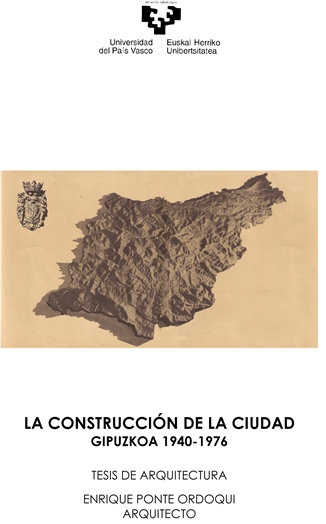ENRIQUE PONTE ORDOQUI
LA CONSTRUCCIÓN DE LA CIUDAD: GIPUZKOA 1940-1976
ABSTRACT EN CASTELLANO
La Tesis, sobre desarrollo urbano, se refiere a un ámbito territorial acotado y analiza un escenario histórico relativamente reciente, ambos muy precisos: el territorio de Gipuzkoa como espacio natural y administrativo, y el periodo correspondiente a la dictadura franquista iniciada mediante levantamiento militar contra el orden constitucional establecido.
Para disponer de una perspectiva amplia de la situación urbanística y arquitectónica que se disponía anteriormente, durante la República, se efectúa una referencia a las manifiestos lanzados por la vanguardia desde los Congresos Internacionales de Arquitectura Moderna (CIAM) y, en el caso español, desde el GATEPAC, con la referencia de la “Carta de Atenas” en la que se estableció la configuración de un nuevo concepto de abordar el fenómeno urbano, la Ciudad Funcional, que se configuraría durante el periodo siguiente, a pesar de todo, como elemento de referencia teórica.
Una vez concluida la contienda se crearon, a efectos de regular los desarrollos urbanísticos y arquitectónicos y con un marcado espíritu centralizador, una serie de Organismos públicos estatales (Regiones Devastadas, Instituto Nacional de la Vivienda, Dirección Gral. de Arquitectura, Obra Sindical del Hogar, etc.) que dentro de un marco caracterizado por el aislamiento internacional, léase autarquía, estuvo acompañado de todo tipo de carencias de orden político, social y económico. Además, se dio la circunstancia de que al frente de organismos estatales que iban a marcar las directrices fundamentales se encontraban el arquitecto elgoibarrés Pedro Muguruza Otaño como primer Director General de Arquitectura y el donostiarra Pedro Bidagor Lasarte, como Jefe Nacional de Urbanismo y, posteriormente, Director General de Urbanismo, los cuales dirigieron su actividad, de manera destacada y singular, a su territorio de origen.
Desde ese encuadre, y bajo los epígrafes “Ciudades en ruina”, “La vivienda social” y “Guipúzcoa orgánica” en la Tesis se analizan los procesos de planificación y desarrollo de las localidades seriamente afectadas por los hechos bélicos (Irún, Eibar y Elgueta); el desarrollo de agrupaciones residenciales de tipo “viviendas sociales” promovidas a lo largo y ancho de Gipuzkoa por parte de la Obra Sindical del Hogar, fundamentalmente aunque no exclusiva, dado que otros entes públicos y privados también actuaron; y la configuración de un prototipo nacional de Ordenación Territorial -el Plan de Ordenación de Guipúzcoa de 1942- que conllevaría la conformación de la Comisión del Plan de Ordenación que impulsó la elaboración de los primeros Planes Generales de las Villas Industriales y del, aunque frustrado en su culminación, Plan General de San Sebastián en el año 1950.
A partir de la promulgación de la Ley del Suelo en el año 1956 y del Plan de Estabilización, se produjo un importante desarrollo industrial en el conjunto de la provincia que generó un fuerte incremento de inmigración conformándose unos nuevos procesos urbanísticos (con la aprobación de diversos documentos de planeamiento general (entre otros el de San Sebastián, en el año 1962) y territorial (Plan de Ordenación Provincial “Plan Doxiadis”) junto con la implantación de nuevas redes de infraestructuras (autopista Bilbao-Behobia, entre otras) y que son analizados en la Tesis.
Durante aquel periodo de tiempo, el vinculado al “desarrollismo”, se provocaría, previa tramitación de gran número de documentos de planeamiento parcial una importante, por su número, intervención residencial pública (Plan Guipúzcoa de la Gerencia de Urbanización) y, sobre todo, privada mediante la aparición de una nueva figura, la del promotor, cuya base de actuación se fundamentaba, en la mayor parte de las casos, en la especulación a los efectos de obtener el mayor beneficio económico. Y ello al margen de las premisas fundamentales que constituyen las buenas reglas que deben configurar la “Construcción de la Ciudad”.
Aquella forma de actuar implicó la materialización de Polígonos densos y dispersos caracterizados por un deficiente nivel de urbanización, una desconexión con la estructura urbana de los núcleos en los que se implantaron y con la carencia de los necesarios elementos dotacionales y de equipamiento. Realidad esta que sería socialmente contestada con mayor intensidad tras la muerte del dictador. La reconsideración y posibilitad de reconducir la situación quedaría facilitada desde el cambio derivado de aquella circunstancia, y ello desde la configuración de una nueva estructura política estatal, autonómica y provincial.
La Tesis concluye con el momento en el que una renovada situación se destacaría por la participación de una nueva generación de profesionales sentándose, con todo ello en Gipuzkoa, las bases para dar inicio, a partir de entonces, a un nuevo proceso cuyo objetivo fundamental, en sentido amplio, sería la “Recuperación de la Ciudad”.





